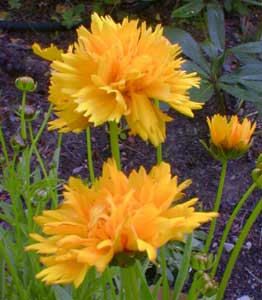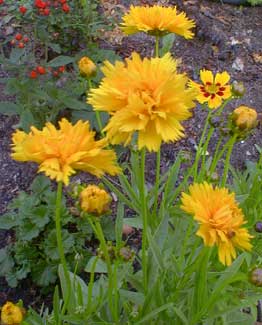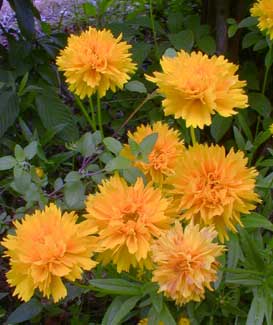
'Early Sunrise'
Coreopsis or Tickseed
"The rain to the wind said,
'You push & I'll pelt.'
They so smote the garden bed
That the flowers actually knelt,
And lay lodged -- though not dead.
I know how the flowers felt."
-Robert Frost
(1874-1963)
(1874-1963)
This perennial is as flowery as many an annual, & it thrives in hot & droughty xeriscape gardens, with a very long bloom period.
Coreopsis grandiflora cultivars can become leggy & tippy if grown in crowded conditions, but are generally sturdy & upright to eighteen inches if it gets good sun from top to bottom of the clump. They will also flop over or "lodge" if overwatered, or if there has been heavy rainfall. 'Early Sunrise' is a bit shorter than most cultivars, but even so, it does sometimes happen that it ends up in need of staking.
They bloom really well in any case, & are not at risk of rotting out unless the soil drains poorly during late autumn & through winter dormancy. Ours hasn't lodged too badly so I don't stake it, but any blooms around the edge of the clump that tip over I just clip off for an indoor bouquet.
 That potential to flop is usually no problem in a dry very sunny not too crowded spot, but if it happens, another way to handle it is to just sheer the plant back to its basal foliage, & let it start again. When most of the clump looks like it could do with some deadheading anyway, it may be worth sacrificing the entire top to get a tighter clump for rebloom. If the problem recurs it should be transplanted to an area where it will remain a bit dryer & get better sun-coverage.
That potential to flop is usually no problem in a dry very sunny not too crowded spot, but if it happens, another way to handle it is to just sheer the plant back to its basal foliage, & let it start again. When most of the clump looks like it could do with some deadheading anyway, it may be worth sacrificing the entire top to get a tighter clump for rebloom. If the problem recurs it should be transplanted to an area where it will remain a bit dryer & get better sun-coverage.The species is not called "grandiflora" for nothing. The intensity of its mix of semi-double & fully-double golden flowers, & the sheer numbers of them produced by a single clump, is awesome. It's in full bloom by June, & persists until first frost of autumn, or a little longer (blooms from May to November are not improbable).
They can be grown in zones 4 through 9, though at the colder end of the scale it will likely be an annual, or will need heavy mulching with straw for the roots to survive the winter, the straw being cleared away at the start of spring. It also does have its limits for sunny dryness, & at the height of a summer drought, it will not look good, & may die, if water isn't gotten to it from time to time.
 Ultra-flowery perennials are often heavy feeders, but coreopsis is not. It likes a light poor soil best, but a single yearly feeding of a mild slow-release fertilizer, given to it late winter or early spring, can do it some good.
Ultra-flowery perennials are often heavy feeders, but coreopsis is not. It likes a light poor soil best, but a single yearly feeding of a mild slow-release fertilizer, given to it late winter or early spring, can do it some good.Developed from a North American wildflower, 'Early Sunrise' is the 1989 All-America Selections Gold Medal winner, & also received Europe's Europe's Fleuroselect Gold Medal. ASS awards go to varieties t hat grow well from seed, but also to great extent the gold medal goes to ornamentals suitable for mass-production for retail commerce. So these awards lack the same cache as the Award of Garden Merit. It does mean they scored well in field tests & have crowd-pleasing qualities. In consequence ASS gold medal winnters end up in wide production & are easily obtained inexpensively.
Both these photos were snapped in June. The second photo captures one single-flower coreopsis in the background with red markings, which is C. lancelolata 'Baby Sun.' Also captured in the second shot are a few red blossoms of Calceolaria integrifolia 'Kentish Hero' slipperwort.
'Sunrise' coreopsis is ideal for the bouquet garden because it has such long straight stems. It is also a favorite of bees & other pollinators. Bees by & large see only blue & yellow, so a mixed bed of, say, blue scabiosas & yellow coreopsis will be great bee-attractants (red flowers are trying to attract other pollinators, including hummingbirds). This is certainly not to say bees don't find red or purple flowers; I see them all over purple rhodies & bright red beebalms (though often the deepest reds actually have some blue in them which our eyes can't see, but are telegraphing to bees). Though bees will pollinate everything, for maximum attraction, blues & yellows excite them best.